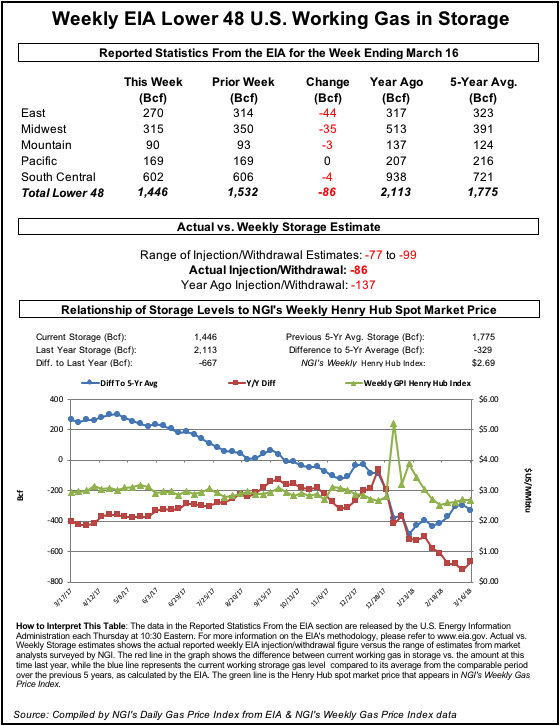Markets | NGI All News Access | NGI Data
EIA’s On Target 86 Bcf Draw Confirms No Urgent Storage Tightness
Industry prognosticators hit it nearly right on the nose Thursday morning as the Energy Information Administration (EIA) reported that 86 Bcf was withdrawn from underground storage for the week ending March 16.

The April natural gas futures contract responded accordingly by remaining within a nickel range. Just prior to the 10:30 a.m. EDT report, the prompt-month contract had worked its way higher to $2.661. In the minutes that followed, the April contract reached a high of $2.667 before backing off to $2.627. As of 11 a.m. EDT, it was trading at $2.630, down eight-tenths of a cent from Wednesday’s regular session close.
Analysts at Bespoke Weather Services noted that the withdrawal “hit expectations,” and that it showed that there is no “urgent tightness” in the supply-demand equation. With no surprise in the size of the withdrawal, Bespoke said the report seemed to temporarily confirm the current trading range.
For the comparable week last year, 137 Bcf was withdrawn from storage and the five-year average withdrawal for the week stands at just 53 Bcf.
Heading into the report, early estimates showed the EIA reporting a storage withdrawal in the upper 80 Bcf to lower 90 Bcf range. A Reuters survey of traders and analysts on average predicted an 87 Bcf withdrawal, with responses ranging from 77 Bcf to 99 Bcf.
Kyle Cooper of IAF Advisors projected a storage draw of 87 Bcf and Stephen Smith Energy Associates forecast a 92 Bcf draw, while OPIS estimated a draw of 89 Bcf, driven by gains in supply offsetting a third week of strong weather-driven demand in the Northeast and Midwest. Intercontinental Exchange EIA storage futures settled at -87 Bcf Wednesday for this week’s report.
As of March 16, working gas in storage levels stand at 1,446 Bcf, according to EIA estimates. Supplies are now 667 Bcf less than last year at this time and 329 Bcf below the five-year average of 1,775 Bcf.
For the week, the East Region withdrew 44 Bcf, and the Midwest was close behind with a 35 Bcf draw. The South Central Region dropped 4 Bcf and the Mountain Region declined by 3 Bcf, while the Pacific Region stood pat with no change from the prior week’s level.
© 2024 Natural Gas Intelligence. All rights reserved.
ISSN © 1532-1231 | ISSN © 2577-9877 |
